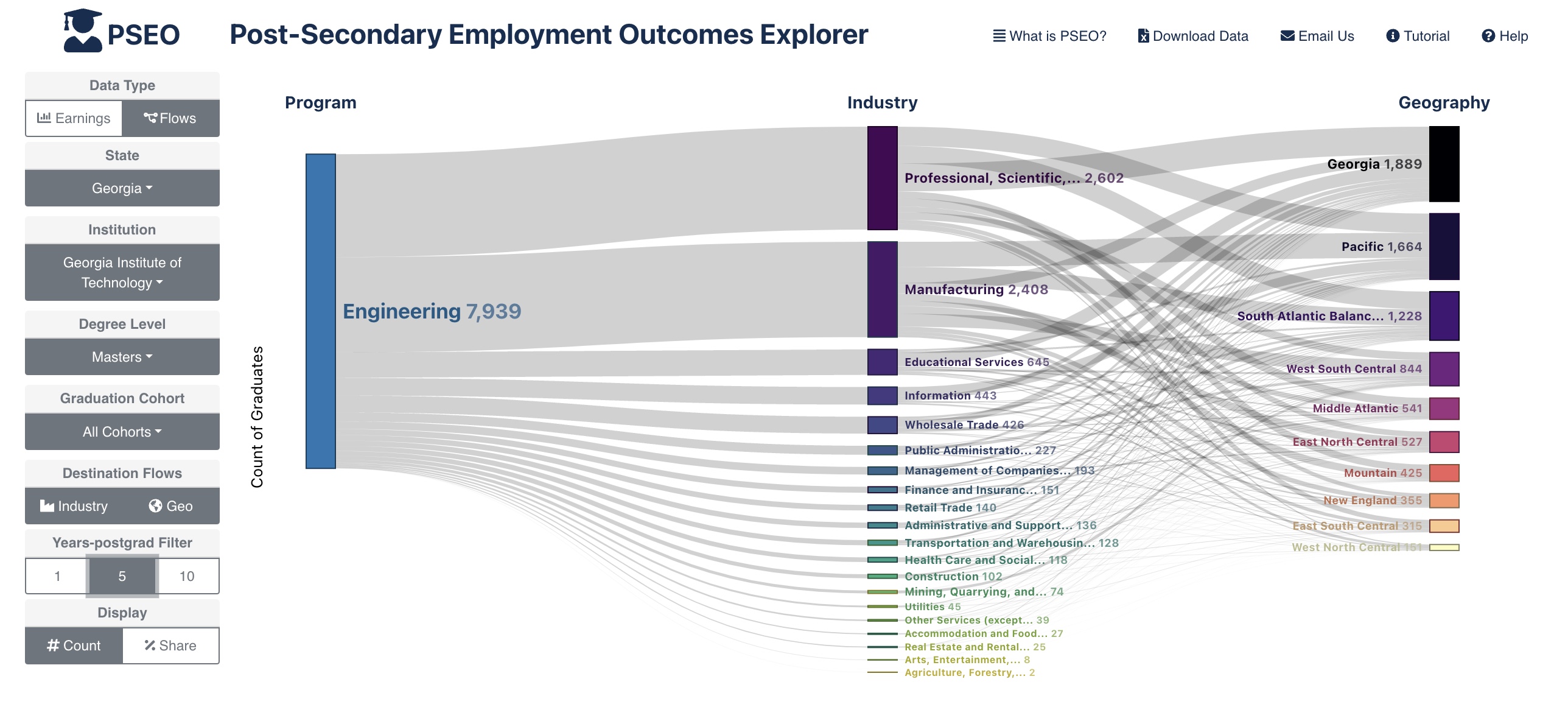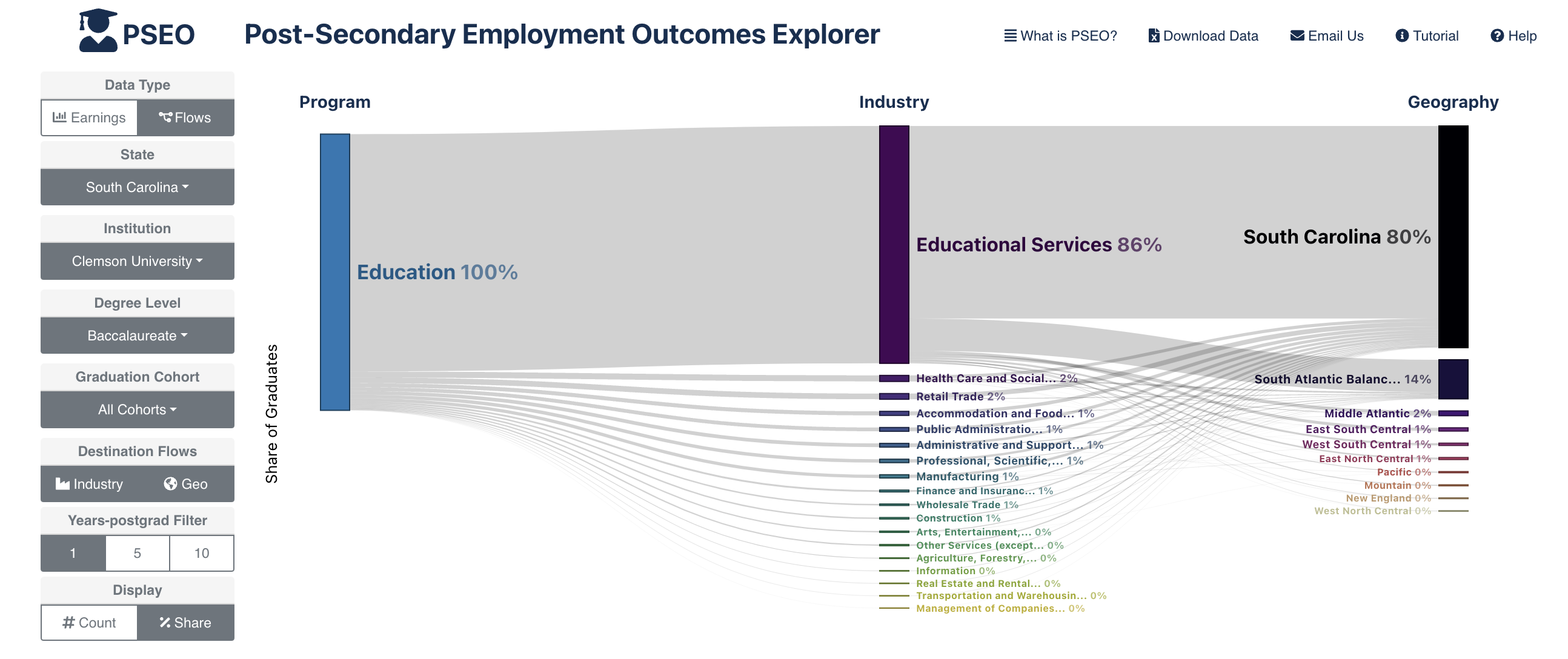In June the U.S. Census Bureau released data for institutions from six new
data partners in the Post-Secondary Employment
Outcomes (PSEO) experimental data product. It was an invitation to
experiment a bit with sorting those data.
What is PSEO? It’s a dataset of experimental tabulations developed by the
Bureau’s Center for Economic Studies’ Longitudinal Employer-Household
Dynamics (LEHD) Research program that provides earnings and employment
outcomes for college and university graduates by degree level, degree major
and post-secondary institution. The statistics are generated by matching
university transcript data with a national database of jobs, “using
state-of-the-art confidentiality protection mechanisms to protect the
underlying data,” says the Bureau.
After having data from only Texas and Colorado as recently as 2018, PSEO
now includes data on 825 institutions from 27 states which cover more than
29% of all college graduates in the United States in 2015. All the data is
downloadable or accessible for research via the PSEO Explorer tool. Graduate
earnings are available at the 25th, 50th, and 75th percentiles for one,
five, and 10 years after graduation. Employment Flows provide industry and
location of employment for graduates.
“Economic considerations drive a number of college decisions — whether to
attend college, where to attend, and what major to select,” the Bureau
explains. “Given the resources required to attend college, students want to
know whether programs are likely to have a sufficient return to justify
their expense. Prospective students would also like to know what labor
markets recent graduates are working in and whether or not they are
employed in an industry appropriate for their training.”
Employers would like to know those things too.
Warning: Be ready for some serious
exploration. The full spreadsheet of credentials and post-secondary
earnings data has more than 344,000 rows.
But you can sort those rows if you want. The Employment Flows option will
tell you whether graduates of a particular institution or area of study at
that institution are staying in the region or flying the coop. For example,
it appears that nearly half of the almost 20,000 engineering baccalaureate
students at Georgia Institute of Technology (Georgia Tech) remain in
Georgia one year after matriculating, with another 2,500 spread across the
South Atlantic region. At the masters degree level five years after leaving
the institution, the split is more balanced among Georgia, the South
Atlantic and the West Coast.
 |
|
PSEO data show masters degree students in engineering from
Georgia Tech migrate toward professional, scientific and
technical services and manufacturing, with a geographic split
five years on among Georgia, the West Coast and the South
Atlantic region.
|
Earnings are reported in 2020 dollars. The PSEO tool also allows for
adjustment of cohorts by year, so users can see how earnings change for
graduates of the same course at the same institution.
Then there is the nature of that phrase “experimental tabulations.” Among
the limitations set out by the Bureau:
- “College Scorecard data from the U.S. Department of Education are
restricted to federal aid recipients, who may not be representative of
the student population. College Scorecard data also include everyone who
enrolled in the institution and does not separate out those that
received a degree from those who did not.”
- “PayScale, a commercial website, publishes earnings by institution and
degree, but relies on voluntary self-reported earnings, not generally
considered a scientifically valid sampling method. Many states, such as
Texas, have matched transcript data to state job records to produce
statistics on earnings and employment for graduates. However, state
administrative data systems cannot follow students out of state, biasing
earnings and employment downward in the matched data.”
Indeed, the Texas focus on data yields meaningful and actionable findings.
Texas
CREWS (Consumer Resource for Education and Workforce Statistics), a
joint project of the Texas Workforce Commission and the Texas Higher
Education Coordinating Board, offers interactive dashboards that “help you
compare Texas public universities, public colleges, majors and career
schools based on graduate wages, student loan levels, graduation rates and
more.”
One of the best resources is also one of the schools listed above: Texas
A&M, where the data science department offers regular
analyses of PSEO and other national and state workforce data.
PSEO is just one subset of a gold mine of LEHD data that cover 96% of
employment in the United States and serve as source data for the U.S.
Census Bureau’s Quarterly Workforce Indicators (QWI), LEHD
Origin-Destination Employment Statistics (LODES), and, perhaps of most
interest as yet another valuable Census Bureau resource for corporate real
estate professionals and site consultants, Job-to-Job Flows (J2J). — Adam Bruns
 |
|
A screen grab from the PSEO Explorer tool shows the flow of
education program graduates from Clemson University by industry
sector and by geography.
|
|
Image courtesy of U.S. Census Bureau
|
|